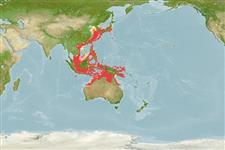أشلاق (القروش و الشفانين) (sharks and rays) >
Heterodontiformes (Bullhead and horn sharks) >
Heterodontidae (Bullhead, horn, or Port Jackson sharks)
Etymology: Heterodontus: heteros (Gr.), different; odontos (Gr.), tooth, referring to pointy teeth (for clutching prey) at front of jaws, different than rounded molar-like teeth (for grinding hard-shelled invertebrates) at the back. (See ETYFish); zebra: Referring to 12 narrow brown or black zebra-like stripes on body. (See ETYFish).
More on author: Gray.
Environment: milieu / climate zone / depth range / distribution range
البيئة
بحري مرتبطة بالشعاب; نطاق العمق 0 - 200 m (Ref. 6871). Subtropical; 40°N - 20°S, 103°E - 155°E
Western Pacific: Japan to northwestern Australia (Ref. 6871) and Queensland.
Length at first maturity / الحجم / وزن / العمر
Maturity: Lm ?, range 84 - ? cm
Max length : 125 cm TL ذكر/ مختلط الجنس; (Ref. 2334)
الأشواك الظهرية (المجموع): 2; الأشعة الظهرية الناعمة (المجموع): 0; شوكة شرجية 0; أشعه شرجية لينه: 0. The Zebra bullhead shark, Heterodontus zebra, has a large blunt head, low supra-orbital crest gradually sloping behind eyes, dorsal fin spines, anal fin, and zebra-pattern of dark, narrow vertical bands on a pale background (Ref. 9838; 6871). As characteristic of members of the family, caudal fin with a moderately long dorsal lobe and moderately long ventral lobe, the latter shorter than the dorsal lobe, vertebral axis raised into caudal-fin lobe (Ref.9838).
A common but little-known shark found on the continental and insular shelves in depths down to at least 50 m (Ref. 247, 11230) in the South China Sea, but deeper and in 150 - 200 meters off Western Australia (Ref. 43278). Probably feeds on bottom invertebrates and small fishes (Ref. 6871). Oviparous (Ref. 247).
Life cycle and mating behavior
النضج | التكاثر | وضع البيض | بيض | الخصوبة | Larvae
Oviparous, paired eggs are laid. Embryos feed solely on yolk (Ref. 50449). Distinct pairing with embrace (Ref. 205). Lays auger type eggs (about 12-18cm, 4.7-7 inches long) among rocks & kelp, often with more than female using same oviposition site, with as many eggs found in a single nest; female lay 2 eggs at a time, from spring to late summer in Japan, 6-12 times during a single spawning season. Eggs hatch in 1 year. Hatch at 18 cm (7 inches), max length at 1.2m (3.9 ft.). During courtship, male grasps pectoral fin of female & wraps posterior part of body under her so single clasper can be inserted into her cloaca. In several mating bouts observed, copulation lasted as long as 15 minutes (Ref. 12951).
Compagno, L.J.V., 2001. Sharks of the world. An annotated and illustrated catalogue of shark species known to date. Vol. 2. Bullhead, mackerel and carpet sharks (Heterodontiformes, Lamniformes and Orectolobiformes). FAO Spec. Cat. Fish. Purp. 1(2):269 p. FAO, Rome. (Ref. 43278)
IUCN Red List Status (Ref. 130435)
خطر للأنسان
Traumatogenic
استخدامات بشرية
مصائد: غير مهمة تجارياً; حوض مائي: محتملة
مزيد من المعلومات
مراجعالأستزراع المائيملف الأستزراع المائيسلالاتجينيElectrophoresesالتوريثالأمراضمعالجةNutrientsMass conversion
أدوات
تقارير خاصة
Download XML
مصادر علي الأنترنت
Estimates based on models
Preferred temperature (Ref.
123201): 15.4 - 26.6, mean 21.8 °C (based on 223 cells).
Phylogenetic diversity index (Ref.
82804): PD
50 = 0.5059 [Uniqueness, from 0.5 = low to 2.0 = high].
Bayesian length-weight: a=0.00380 (0.00166 - 0.00872), b=3.15 (2.95 - 3.35), in cm total length, based on LWR estimates for this (Sub)family-body shape (Ref.
93245).
مستوى غذائي (Ref.
69278): 4.0 ±0.66 se; based on food items.
المرونه (Ref.
120179): منخفض, الحد الزمني الأدني لتضاعف عدد أفراد المجتمع 4.5-14 سنة (Fec assumed to be <100).
Fishing Vulnerability (Ref.
59153): High to very high vulnerability (75 of 100).
